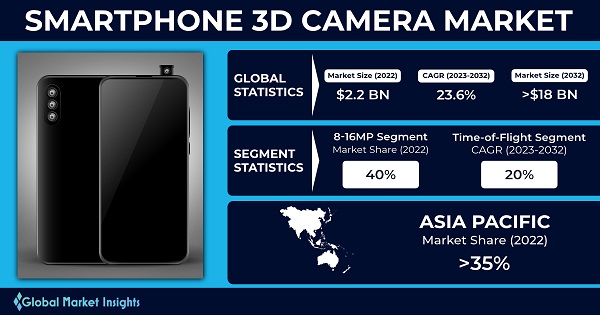Home > Consumer Goods & Services > Consumer Electronics > Smartphone 3D Camera Market
Smartphone 3D Camera Market Size
- Report ID: GMI7085
- Published Date: Oct 2023
- Report Format: PDF
Smartphone 3D Camera Market Size
Smartphone 3D Camera Market was valued at over USD 2.2 billion in 2022 and is anticipated to grow at a CAGR of over 23.6% between 2023 and 2032. Augmented Reality (AR) technology is revolutionizing the way consumers shop online. Virtual try-on experiences, AR-based product demonstrations, and interactive advertisements are gaining popularity. Smartphone 3D cameras enable more accurate object recognition and tracking, enhancing these AR applications. Retailers leverage AR for virtual try-on experiences, allowing customers to visualize products, such as clothing and cosmetics, before purchase. For instance, in June 2022, Amazon Fashion launched a virtual try-on for shoes, a mobile experience that allows iOS users to interact and use AR to see how a pair of shoes will look on them from all angles. 3D cameras enable precise mapping of the user's body and face, enhancing the realism of virtual try-ons. As e-commerce embraces AR, smartphones with advanced 3D imaging will become integral to the shopping experience.
Smartphone 3D cameras are specialized imaging systems integrated into smartphones that capture three-dimensional depth information. Utilizing technologies including structured light or Time-of-Flight (ToF), they measure distances between the camera and objects, enabling AR experiences, facial recognition, 3D scanning, and immersive gaming. These cameras enhance user interactions and enable creative applications by capturing the depth of the scene or subject being photographed.
| Report Attribute | Details |
|---|---|
| Base Year: | 2022 |
| Smartphone 3D Camera Market Size in 2022: | USD 2.2 Billion |
| Forecast Period: | 2023 to 2032 |
| Forecast Period 2023 to 2032 CAGR: | 23.6% |
| 2032 Value Projection: | USD 18 Billion |
| Historical Data for: | 2018 to 2022 |
| No. of Pages: | 200 |
| Tables, Charts & Figures: | 193 |
| Segments covered: | Technology, Resolution, and Region |
| Growth Drivers: |
|
| Pitfalls & Challenges: |
|
Processing 3D imaging data and running AR applications can be resource-intensive, affecting the device's battery life. Consumers often prioritize smartphones with longer battery endurance, posing a challenge for 3D camera-equipped devices to balance performance and energy efficiency.

